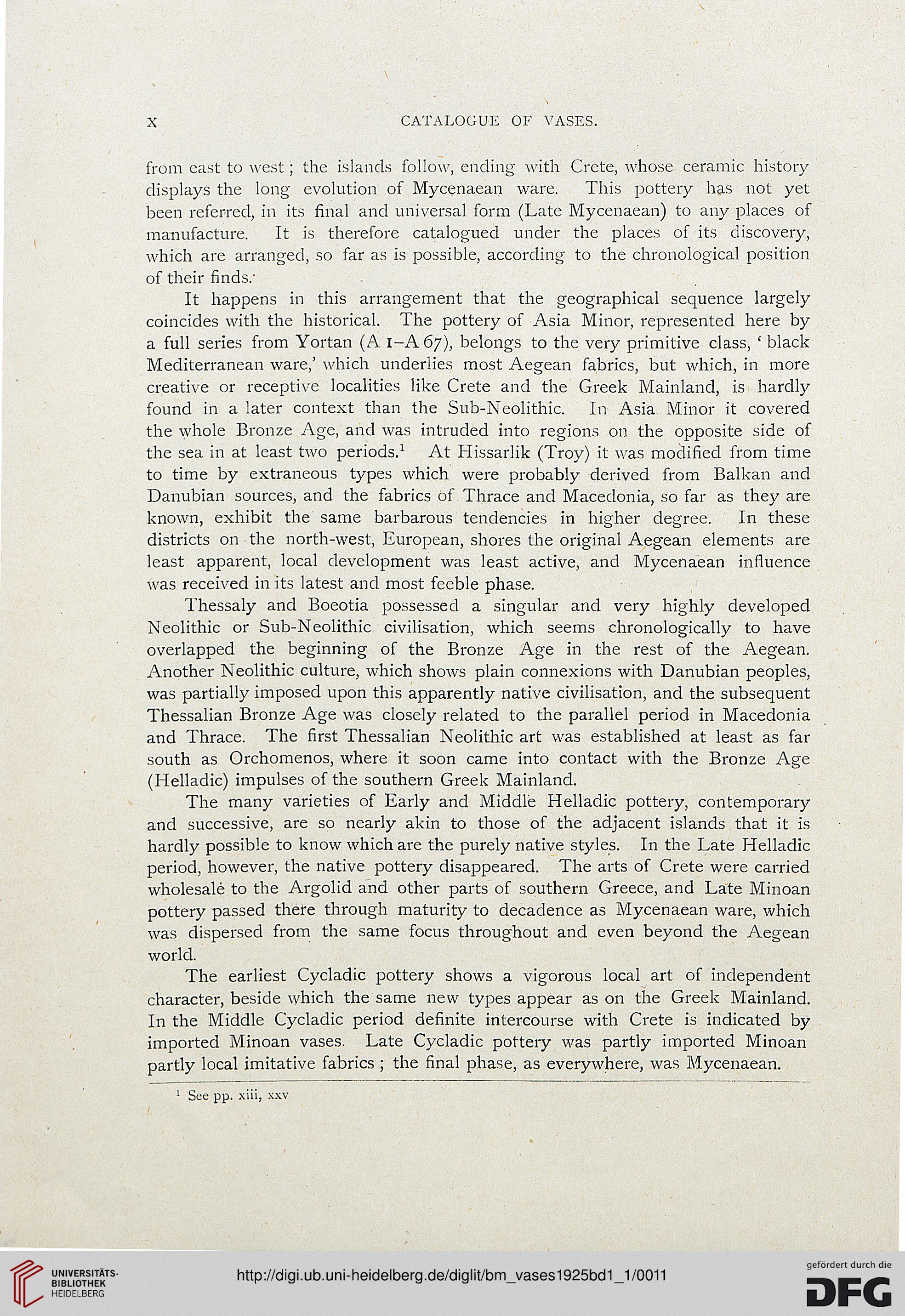X CATALOGUE OF VASES.
from cast to west ; the islands follow, ending' with Crete, whose ceramic history
displays the long evolution of Mycenaean ware. This pottery has not yet
been referred, in its final and universal form (Late Mycenaean) to any places of
manufacture. It is therefore catalogued under the places of its discovery,
which are arranged, so far as is possible, according to the chronological position
of their finds/
It happens in this arrangement that the geographical sequence largely
coincides with the historical. The pottery of Asia Minor, represented here by
a full series from Yortan (A i-A 67), belongs to the very primitive class, ' black
Mediterranean ware,' which underlies most Aegean fabrics, but which, in more
creative or receptive localities like Crete and the Greek Mainland, is hardly
found in a later context than the Sub-Neolithic. In Asia Minor it covered
the whole Bronze Age, and was intruded into regions on the opposite side of
the sea in at least two periods.1 At Hissarlik (Troy) it was modified from time
to time by extraneous types which were probably derived from Balkan and
Danubian sources, and the fabrics of Thrace and Macedonia, so far as they are
known, exhibit the same barbarous tendencies in higher degree. In these
districts on the north-west, European, shores the original Aegean elements are
least apparent, local development was least active, and Mycenaean influence
was received in its latest and most feeble phase.
Thessaly and Boeotia possessed a singular and very highly developed
Neolithic or Sub-Neolithic civilisation, which seems chronologically to have
overlapped the beginning of the Bronze Age in the rest of the Aegean.
Another Neolithic culture, which shows plain connexions with Danubian peoples,
was partially imposed upon this apparently native civilisation, and the subsequent
Thessalian Bronze Age was closely related to the parallel period in Macedonia
and Thrace. The first Thessalian Neolithic art was established at least as far
south as Orchomenos, where it soon came into contact with the Bronze Age
(Helladic) impulses of the southern Greek Mainland.
The many varieties of Early and Middle Helladic pottery, contemporary
and successive, are so nearly akin to those of the adjacent islands that it is
hardly possible to know which are the purely native styles. In the Late Helladic
period, however, the native pottery disappeared. The arts of Crete were carried
wholesale to the Argolid and other parts of southern Greece, and Late Minoan
pottery passed there through maturity to decadence as Mycenaean ware, which
was dispersed from the same focus throughout and even beyond the Aegean
world.
The earliest Cycladic pottery shows a vigorous local art of independent
character, beside which the same new types appear as on the Greek Mainland.
In the Middle Cycladic period definite intercourse with Crete is indicated by
imported Minoan vases. Late Cycladic pottery was partly imported Minoan
partly local imitative fabrics ; the final phase, as everywhere, was Mycenaean.
1 See pp. xiii, xxv
from cast to west ; the islands follow, ending' with Crete, whose ceramic history
displays the long evolution of Mycenaean ware. This pottery has not yet
been referred, in its final and universal form (Late Mycenaean) to any places of
manufacture. It is therefore catalogued under the places of its discovery,
which are arranged, so far as is possible, according to the chronological position
of their finds/
It happens in this arrangement that the geographical sequence largely
coincides with the historical. The pottery of Asia Minor, represented here by
a full series from Yortan (A i-A 67), belongs to the very primitive class, ' black
Mediterranean ware,' which underlies most Aegean fabrics, but which, in more
creative or receptive localities like Crete and the Greek Mainland, is hardly
found in a later context than the Sub-Neolithic. In Asia Minor it covered
the whole Bronze Age, and was intruded into regions on the opposite side of
the sea in at least two periods.1 At Hissarlik (Troy) it was modified from time
to time by extraneous types which were probably derived from Balkan and
Danubian sources, and the fabrics of Thrace and Macedonia, so far as they are
known, exhibit the same barbarous tendencies in higher degree. In these
districts on the north-west, European, shores the original Aegean elements are
least apparent, local development was least active, and Mycenaean influence
was received in its latest and most feeble phase.
Thessaly and Boeotia possessed a singular and very highly developed
Neolithic or Sub-Neolithic civilisation, which seems chronologically to have
overlapped the beginning of the Bronze Age in the rest of the Aegean.
Another Neolithic culture, which shows plain connexions with Danubian peoples,
was partially imposed upon this apparently native civilisation, and the subsequent
Thessalian Bronze Age was closely related to the parallel period in Macedonia
and Thrace. The first Thessalian Neolithic art was established at least as far
south as Orchomenos, where it soon came into contact with the Bronze Age
(Helladic) impulses of the southern Greek Mainland.
The many varieties of Early and Middle Helladic pottery, contemporary
and successive, are so nearly akin to those of the adjacent islands that it is
hardly possible to know which are the purely native styles. In the Late Helladic
period, however, the native pottery disappeared. The arts of Crete were carried
wholesale to the Argolid and other parts of southern Greece, and Late Minoan
pottery passed there through maturity to decadence as Mycenaean ware, which
was dispersed from the same focus throughout and even beyond the Aegean
world.
The earliest Cycladic pottery shows a vigorous local art of independent
character, beside which the same new types appear as on the Greek Mainland.
In the Middle Cycladic period definite intercourse with Crete is indicated by
imported Minoan vases. Late Cycladic pottery was partly imported Minoan
partly local imitative fabrics ; the final phase, as everywhere, was Mycenaean.
1 See pp. xiii, xxv





